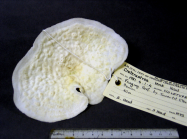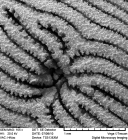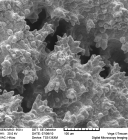WoRMS taxon details
Craterastrea levis Head, 1983
216131 (urn:lsid:marinespecies.org:taxname:216131)
accepted
Species
marine, fresh, terrestrial
Head, S.M. 1983. An undescribed species of Merulina and a new genus and species of siderastreid coral from the Red Sea. Journal of Natural History 17: 419-435. [details]
Holotype NHMUK 1981.4.1.4, verbatimGeounit Towartit,...
, Note Towartit, Port Sudan, Sudan
Holotype NHMUK 1981.4.1.4, verbatimGeounit Towartit, Port Sudan... [details]
Type locality Towartit, Port Sudan, Sudan [details]
Description So far this genus has been found only in the Red Sea and Chagos Archipelago. It occurs only deep on the reef slope. In...
Description So far this genus has been found only in the Red Sea and Chagos Archipelago. It occurs only deep on the reef slope. In Chagos, it provides substantial cover (over 50%) on seaward reef slopes of some atoll slopes at depths of 45 to 60 metres and probably more, while in the Red Sea it likewise occurred on the deeper reef. Probably it is more widespread than present records suggest, but is perhaps rarely noticed because of the depth at which it lives. The coral forms thick plates which project out from the substrate. The plates may exceed 40 cm across. It is grey brown when living, though no photographs of the living coral are known. (Live specimens don't look much different to the bleached skeleton!) The surface is remarkably smooth in appearance. It contains closely packed beaded septo-costae, and small, scattered calices. Many specimens have very few calices at all. (Sheppard, 1998 <308>) [details]
Hoeksema, B. W.; Cairns, S. (2024). World List of Scleractinia. Craterastrea levis Head, 1983. Accessed through: World Register of Marine Species at: https://www.marinespecies.org/aphia.php?p=taxdetails&id=216131 on 2024-04-20
Date
action
by
![]() The webpage text is licensed under a Creative Commons Attribution 4.0 License
The webpage text is licensed under a Creative Commons Attribution 4.0 License
original description
Head, S.M. 1983. An undescribed species of Merulina and a new genus and species of siderastreid coral from the Red Sea. Journal of Natural History 17: 419-435. [details]
basis of record Sheppard, C.R.C. (1998). Corals of the Indian Ocean: a taxonomic and distribution database for coral reef ecologists [details]
additional source Benzoni, F., Arrigoni, R., Stefani, F., Stolarski, J., 2012. Systematics of the coral genus Craterastrea (Cnidaria, Anthozoa, Scleractinia) and description of a new family through combined morphological and molecular analyses. Systematics and Biodiversity 10(4): 417–433. [details]
additional source Sheppard CRC. (1987). Coral species of the Indian Ocean and adjacent seas: a synonymised compilation and some regional distribution patterns. <em>Atoll Research Bulletin.</em> 307: 1-32., available online at http:// https://doi.org/10.5479/si.00775630.307.1 [details]
basis of record Sheppard, C.R.C. (1998). Corals of the Indian Ocean: a taxonomic and distribution database for coral reef ecologists [details]
additional source Benzoni, F., Arrigoni, R., Stefani, F., Stolarski, J., 2012. Systematics of the coral genus Craterastrea (Cnidaria, Anthozoa, Scleractinia) and description of a new family through combined morphological and molecular analyses. Systematics and Biodiversity 10(4): 417–433. [details]
additional source Sheppard CRC. (1987). Coral species of the Indian Ocean and adjacent seas: a synonymised compilation and some regional distribution patterns. <em>Atoll Research Bulletin.</em> 307: 1-32., available online at http:// https://doi.org/10.5479/si.00775630.307.1 [details]
 Present
Present  Present in aphia/obis/gbif/idigbio
Present in aphia/obis/gbif/idigbio  Inaccurate
Inaccurate  Introduced: alien
Introduced: alien  Containing type locality
Containing type locality
Holotype NHMUK 1981.4.1.4, verbatimGeounit Towartit, Port Sudan... [details]
From editor or global species database
Type locality Towartit, Port Sudan, Sudan [details]From other sources
Description So far this genus has been found only in the Red Sea and Chagos Archipelago. It occurs only deep on the reef slope. In Chagos, it provides substantial cover (over 50%) on seaward reef slopes of some atoll slopes at depths of 45 to 60 metres and probably more, while in the Red Sea it likewise occurred on the deeper reef. Probably it is more widespread than present records suggest, but is perhaps rarely noticed because of the depth at which it lives. The coral forms thick plates which project out from the substrate. The plates may exceed 40 cm across. It is grey brown when living, though no photographs of the living coral are known. (Live specimens don't look much different to the bleached skeleton!) The surface is remarkably smooth in appearance. It contains closely packed beaded septo-costae, and small, scattered calices. Many specimens have very few calices at all. (Sheppard, 1998 <308>) [details]


